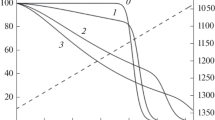Abstract
A kinetic model of the medium (least complicated kinetic mechanism) is constructed for the formation of combustible nitrogen oxides in coal-dust flares. The model includes both the yield kinetics of volatiles from the coal with formation of a fuel gas mixture and the chemical reaction kinetics in the gaseous phase, which describe the conversion of nitrogen-containing components into NO during the combustion of the volatiles.
Similar content being viewed by others
References
A. A. Levitskii, S. A. Losev, and V. N. Makarov, “Chemical kinetics problems in the AVOGADRO automated scientific research system,” in:Mathematical Models in Chemical Kinetics [in Russian], Nauka, Novosibirsk (1990), pp. 7–38.
G. Ya. Gerasimov and V. N. Makarov, “Analysis of the mechanism, for a complex chemical reaction with radiation-chemical decontamination of gases as an example,”Khim. Fiz.,16, No. 1, 89–99 (1997).
P. V. Roslyakov, “Calculating the formation of nitrogen oxides during combustion of nitrogen-containing fuels,”Teploénergetika, No. 1, 37–41 (1986).
Y. H. Song, D. W. Blair, V. J. Siminski, and W. Bartok, “Conversion of fixed nitrogen to N2 in rich combustion,” in:Proc. 18th Symp. (Int.) on Combustion, The Combustion Inst. (1981), pp. 53–63.
V. I. Babii and Yu. F. Kuvaev,Burning of Coal Dust and the Design of Coal-Dust Flares [in Russian], Energoatomizdat, Moscow (1986).
P. H. Solomon and D. G. Hamblen, “Pyrolysis,” in: R. H. Schlosberg (ed.),Chemistry of Coal Conversion, Plenum Press, New York, (1985), pp. 121–252.
P. K. Agarwal, J. B. Agnew, N. Ravindran, and R. Weimann, “Distributed kinetic parameters for evolution of gaseous species in the pyrolysis of coal,”Fuel,66, 1097–1106 (1987).
A. Attar and G. G. Hendrickson, “Functional groups and heteroatoms in coal,” in: R. A. Meyers (ed.),Coal Structure, New York (1982), pp. 131–198.
G. H. Ko, W. A. Peters and J. B. Howard, “Correlation of tar yields from rapid pyrolysis with coal type and pressure,”Fuel,66, 1118–1122 (1987).
N. J. Pitz and C. K. Westbrook, “A comprehensive chemical kinetic reaction mechanism for the oxidation ofn-butane,” in:Proc. 20th Symp. (Int.) on Combustion, The Combustion Inst. (1984), pp. 831–843.
D. S. Y. Hsu, C. Y. Lin, and M. C. Lin, “CO formation in the early stage of high temperature benzene oxidation under fuel lean conditions: Kinetics of the initiation reaction C6H6→C6H5+H,”ibid., Proc 20th Symp. (Int.) on Combustion, The Combustion Inst. (1984), pp. 623–630.
W. A. Hahn and J. O. L. Wendt, “NOx formation in flat, laminar, opposed jet methane diffusion flames,” in:Proc. 18th Symp. (Int.) on Combustion, The Combustion Inst. (1981), pp. 121–131.
M. F. Zhukov, R. A. Kalinenko, A. A. Levitskii, and L. S. Polak,Plasma Chemical Processing of Coal [in Russian], Nauka, Moscow (1990).
V. G. Kashirskii, “Production of benzene hydrocarbons and thiophene by rapid pyrolysis of solid fuels,”Khim. Tverd. Tela, No. 4, pp. 70–72 (1986).
S. P. Titov, V. I. Babii, and V. M. Barabash, “Study of NO formation from nitrogen in fuel during combustion of coal dust,”Teploénergetika, No. 3, 64–67 (1980).
W. Tsang and J. T. Herron, “Chemical kinetic data base for propellant combustion. I. Reactions involving NO, NO2, HNO, HNO2, HCN, and N2O,”J. Phys. Chem. Ref. Data,20, 609–663 (1991).
W. Tsang, “Chemical kinetic data base for propellant combustion. II. Reactions involving CN, NCO, and HNCO,”J. Phys. Chem. Ref. Data,21, 752–791 (1991).
É. P. Volkov, L. I. Zaichik, and V. A. Pershukov,Modelling the Combustion of Solid Fuels [in Russian], Nauka, Moscow (1994).
P. J. Smith, S. C. Hill, and L. D. Smoot., “Theory for NO formation in turbulent coal flames,” in:Proc. 19th Symp. (Int.) on Combustion, The Combustion Inst. (1982), pp. 1263–1270.
G. Ya. Gerasimov, S. A. Losev, and V. N. Makarov, “The AVOGADRO program: Ecological problems in thermal power production,”Inzh.-Fiz. Zh.,69, No. 6, 921–926 (1996).
Author information
Authors and Affiliations
Additional information
Translated fromFizika Goreniya i Vzryva, Vol. 35, No. 2, pp. 23–29, Mach–April 1999.
Rights and permissions
About this article
Cite this article
Makarov, V.N., Gerasimov, G.Y. Kinetic model of the medium for formation of combustible nitrogen oxides in a coal-dust flare. Combust Explos Shock Waves 35, 133–138 (1999). https://doi.org/10.1007/BF02674425
Received:
Issue Date:
DOI: https://doi.org/10.1007/BF02674425



